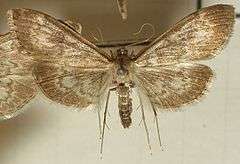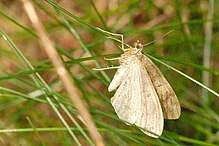Anania lancealis
Anania lancealis is a species of moth of the family Crambidae described by Michael Denis and Ignaz Schiffermüller in 1775.

Mounted specimen
| Anania lancealis | |
|---|---|
| Dorsal view | |
 | |
| Lateral view | |
| Scientific classification | |
| Kingdom: | Animalia |
| Phylum: | Arthropoda |
| Class: | Insecta |
| Order: | Lepidoptera |
| Family: | Crambidae |
| Genus: | Anania |
| Species: | A. lancealis |
| Binomial name | |
| Anania lancealis | |
| Synonyms | |
|
List
| |
Subspecies
- Anania lancealis lancealis
- Anania lancealis bergmani
- Anania lancealis honshuensis
- Anania lancealis pryeri
- Anania lancealis sinensis
- Anania lancealis taiwanensis[2]
Description
The wingspan of Anania lancealis can reach 30–34 mm. Its forewings are long and narrow, especially in males. The upperside of the wings is whitish, with brown lines and patches.[3]
These moths fly at dusk from May to mid-August depending on the location.
The larvae feed on Eupatorium cannabinum,[3] but is also reported on Jacobaea vulgaris, Teucrium scorodonia, Sium latifolium and Stachys. They pupate in a silken cocoon in which they also hibernate.[4]
Distribution and habitat
This species can be found in most of Europe.[5] It prefers woodland and marshy fenland.[3]
gollark: I also did very practical languages like Ancient Greek and Latin.
gollark: Automatically generate additional channels via bot.
gollark: And yet you are in all senses a zygohistomorphic prepromorphism.
gollark: Bold words, for someone identical to magnetic monopoles implementing 802.11ac.
gollark: You're like exactly 26 charm quarks.
References
- "Anania lancealis (Denis & Schiffermüller, 1775)". BioLib.cz. Retrieved 21 January 2018.
- Eugene Munroea and Akira Mutuuraa Contributions to a Study of the Pyraustinae (Lepidoptera: Pyralidae) of Temperate East Asia. III
- "63.017 BF1377 Anania lancealis ([Denis & Schiffermüller], 1775)". UKMoths. Retrieved 21 January 2018.
- "Anania lancealis ([Denis & Schiffermüller], 1775)". Catalogue of the Lepidoptera of Belgium. Retrieved 21 January 2018.
- "Anania lancealis (Denis & Schiffermüller, 1775)". Fauna Europaea. Retrieved 21 January 2018.
External links
- Paolo Mazzei, Daniel Morel, Raniero Panfili Moths and Butterflies of Europe and North Africa
| Wikimedia Commons has media related to Anania lancealis. |
This article is issued from Wikipedia. The text is licensed under Creative Commons - Attribution - Sharealike. Additional terms may apply for the media files.